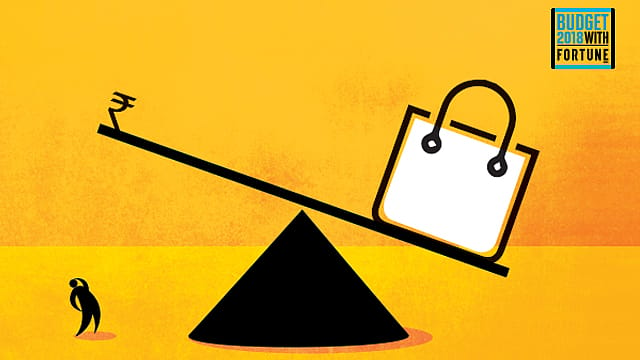Arun Jaitley’s balancing act gets tougher
ADVERTISEMENT

In India, preparing the Union budget is all about tight-rope walking. Year after year, finance ministers have had to ensure that the fiscal deficit—the difference between total expenditure and total revenue of the government—does not balloon out of control.
This year, the task is even trickier. The Fiscal Responsibility and Budget Management Act Review Committee, headed by N.K. Singh, had recommended a fiscal deficit target of 3% of GDP for 2018-19. This target is unlikely to be retained, according to credit rating agency ICRA's chief rating officer Anjan Ghosh and principal economist Aditi Nayar.
"Instead, we expect the government would budget a fiscal deficit for FY2019 between 3.2- 3.5% of GDP, which would be only modestly lower than the revised estimates for FY2018," Ghosh and Nayar noted.
According to Ghosh and Nayar, if nominal GDP growth of 11.4% is assumed in 2018-19, it translates to a fiscal deficit range of Rs. 5,90,000-6,50,000 crore. "Every 10 basis point of expansion in the government's fiscal deficit to GDP ratio, would allow for extra spending of approximately Rs 18,500 crore," the duo add.
"If overall economic growth increases in FY2019, as is widely expected by the market, and inflationary concerns come back to the fore, the appropriateness of a stimulative budget will remain a subject of debate," they further add.
Even for FY18, there will be slippage from the budget estimate, which pegged the fiscal deficit at 3.2% of GDP or Rs 5,50,000 crore. However, between April and November 2017, the fiscal deficit at Rs. 6,10,000 crore is already 33.6% higher than Rs 4,60,000 crore recorded during the same period in 2016. "This was led by higher-than-budgeted expansion in expenditure, amid a contraction in non-tax revenues," say Ghosh and Nayar.
Tax revenues of the government expanded by 16.5% in April-November, 2017, as against the 11.3% growth envisaged in the budget estimate for FY18 over 2016-17. However, this growth rate benefits from the inclusion of inflows of integrated good and service tax (IGST) amounting to Rs. 1,40,000 crore, a part of which would eventually go to the states after adjusting for refunds to the tax payers.
In particular, indirect taxes—customs duty, excise duty, service tax, Central GST, IGST and Union Territory Goods and Services Tax—rose by close to 12.2% in April-November, 2017, higher than the 7.6% growth forecast in budget estimates for 2017-18. Direct tax collections rose by close to 13.7% during April-November 2017, lower than the growth of 17.4% budgeted for fiscal 2017-18.
"Based on this data, the expansion in direct tax collections would need to improve to roughly 21% in the remainder of the fiscal year, to meet the budgeted target," warn ICRA's Ghosh and Nayar. "In particular, the growth in personal income tax collections would need to improve to close to 39% in the remainder of the fiscal year from 15.3% up to November 2017, to meet the budgeted target, which appears somewhat difficult to achieve," the duo adds.
The challenges persist on the non-tax revenues too, as they contracted by a significant 39.7% on annual basis, at Rs 1,10,000 crore in April-November 2017. Given that the fiscal 2017-18 budget envisaged a 5.3% growth in non-tax revenues, the same would need to expand by a whopping 84.6% in the remainder of the fiscal (December 2017 - March 2018).
Dividends and profits of the government stood at Rs 47,120 crore in April-November 2017, 33% below the fiscal 2017-18 budget estimate of Rs 1,40,000 crore. ICRA's Ghosh and Nayar opine that the government needs to garner Rs 95,320 crore in dividends and profits in the last four months of the fiscal to keep a shortfall at bay. "There is a risk of a shortfall of Rs. 15,000 crore to Rs 25,000 crore relative to the dividends and profits that the government had budgeted for 2017-18," Ghosh and Nayar add in their report. This after assuming that the Reserve Bank of India would transfer Rs 13,000 crore to the government—over and above Rs 30,660 crore of surplus transferred in the FY18. This total transfer still does not match the Rs 65,880 crore that central bank transferred to the government in financial year 2016-17.
It is clear finance minister Arun Jaitley has quite a task at his hands. And that this is the last full budget before the next general elections makes it only tougher. "Since it's the last one, the street expects is to be populist," says Anjali Verma, chief economist, PhillipCapital India. However, giveaways can only come from either excessive fiscal slippage or higher revenues. "We see limitations on both," Verma adds. She expects the fiscal deficit to slip to 3.5% in 2017-18, and 3.3% to 3.4% in 2018-19.
January 2026
Netflix, which has been in India for a decade, has successfully struck a balance between high-class premium content and pricing that attracts a range of customers. Find out how the U.S. streaming giant evolved in India, plus an exclusive interview with CEO Ted Sarandos. Also read about the Best Investments for 2026, and how rising growth and easing inflation will come in handy for finance minister Nirmala Sitharaman as she prepares Budget 2026.
